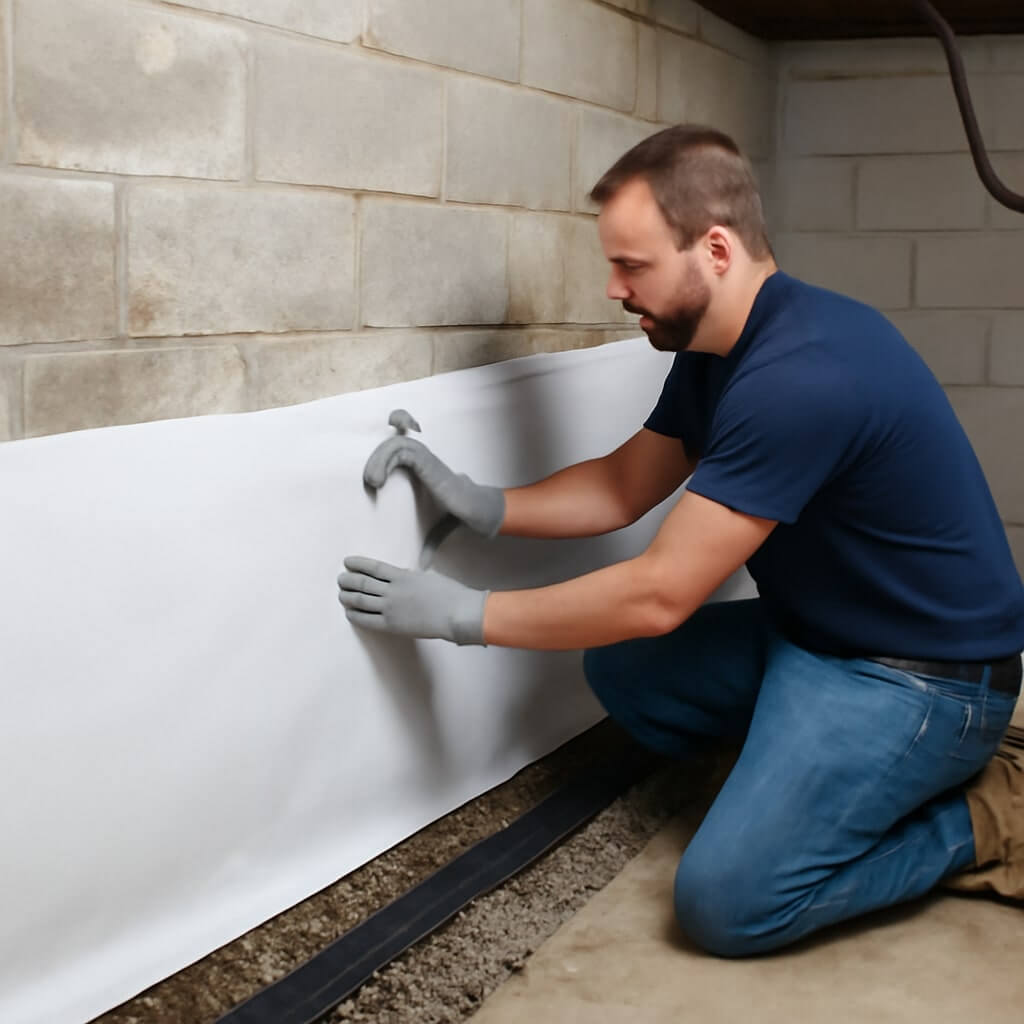When it comes to choosing the right basement waterproofing solutions in Minot, ND, understanding your specific needs is essential. You need to assess your basement for signs of moisture and damage, as well as the effectiveness of your drainage systems. With various options available, both interior and exterior, determining the best approach can be complex. So, what should you consider to guarantee long-lasting protection against water intrusion? Let’s explore the key factors you should keep in mind.
Key Takeaways
- Assess your basement’s unique moisture challenges by conducting inspections and moisture assessments to identify specific waterproofing needs.
- Consider both interior and exterior waterproofing solutions, such as sump pumps and drainage systems, to effectively manage water intrusion.
- Consult with local professionals who understand Minot’s climate and soil conditions, ensuring compliance with local regulations and building codes.
- Utilize advanced tools and techniques that professionals offer, which can enhance the effectiveness and longevity of the waterproofing solution.
- Evaluate the cost-benefit of hiring experts versus DIY options, factoring in potential risks and the value of warranties for peace of mind.
Understanding the Importance of Basement Waterproofing
While you mightn’t think about it often, understanding the importance of basement waterproofing can save you significant time and money in the long run.
Waterproofing your basement offers numerous benefits, including enhanced property value and improved air quality. By investing in moisture prevention, you reduce the risk of mold growth and structural damage, which can lead to costly repairs.
A properly waterproofed basement also allows for increased usable space, whether for storage or as a livable area.
Prioritizing basement waterproofing guarantees that you protect your home and maintain its integrity, ultimately providing peace of mind for you and your family.
Common Causes of Basement Water Intrusion
Understanding the common causes of basement water intrusion is essential for effective waterproofing.
You might encounter issues like poor drainage systems, foundation cracks, and groundwater pressure, all of which can lead to significant water problems.
Identifying these factors early can save you time and money in the long run.
Poor Drainage Systems
One major cause of basement water intrusion is a poorly designed or malfunctioning drainage system.
If your home’s drainage solutions aren’t effectively channeling water away, it can accumulate around your foundation, leading to leaks.
Common issues include clogged gutters, insufficient downspouts, or improper grading of your property.
To enhance water management, make sure your drainage system is regularly maintained and consider installing sump pumps or French drains.
Foundation Cracks
If you neglect to address foundation cracks, you risk significant water intrusion in your basement.
These cracks often result from soil settling, temperature fluctuations, or poor construction practices. Moisture can easily penetrate these openings, leading to mold growth and structural damage.
To combat this, consider professional foundation repair techniques that guarantee your home remains sound and dry. Crack sealing is an imperative part of this process, effectively preventing water from seeping through the fissures.
Regular inspections and timely repairs are vital to maintaining your basement’s integrity and protecting your investment in your property.
Don’t wait for the damage to escalate.
Groundwater Pressure
Ignoring foundation cracks can lead to increased groundwater pressure, a significant factor in basement water intrusion.
As groundwater fluctuations occur, hydrostatic pressure builds up against your foundation walls. This pressure can force water through cracks and porous materials, creating a damp environment in your basement.
When soil becomes saturated, the water table rises, exacerbating the issue. To prevent water intrusion, it’s essential to address foundation issues promptly and consider effective waterproofing solutions.
Assessing Your Basement’s Waterproofing Needs
How do you determine the specific waterproofing needs of your basement? Start with a thorough basement inspection to identify any visible cracks, damp spots, or signs of mold.
Next, conduct a moisture assessment to measure humidity levels and pinpoint areas prone to water intrusion.
Conduct a moisture assessment to gauge humidity levels and identify potential water intrusion sites.
Evaluate the drainage systems around your property, ensuring gutters and downspouts direct water away from the foundation.
Consider the soil type and groundwater levels, as these factors influence your basement’s vulnerability to moisture.
Interior Waterproofing Solutions
When it comes to interior waterproofing solutions, you have several effective options to evaluate.
Installing a sump pump can manage excess water, while interior drainage systems help redirect moisture away from your foundation.
Additionally, employing wall waterproofing techniques will fortify your basement against leaks and humidity.
Sump Pump Installation
While many homeowners overlook the importance of effective drainage, installing a sump pump can be a crucial step in protecting your basement from water damage. You’ll find various sump pump types, such as submersible and pedestal pumps, each with unique benefits. Proper sump pump maintenance, including regular inspections and battery checks, guarantees peak performance.
| Sump Pump Type | Best For | Maintenance Frequency |
|---|---|---|
| Submersible | Flooded basements | Every 6 months |
| Pedestal | Smaller spaces | Annually |
| Battery backup | Power outages | Monthly |
| Combination | Versatile needs | Every 6 months |
Interior Drainage Systems
After ensuring your sump pump is properly installed and maintained, addressing water intrusion through interior drainage systems becomes the next step in basement waterproofing.
Implementing an effective interior drainage solution involves a few key components:
- Perimeter Drainage: Install a drainage system around the basement’s perimeter to collect water.
- Sump Pit: Position a sump pit to gather excess water from the drainage system.
- Drainage Pipe: Use a pipe to direct water from the sump pit to the exterior or municipal drainage.
- Gravel Bed: Surround the drainage pipe with gravel to enhance water flow.
This approach keeps your basement dry and secure.
Wall Waterproofing Techniques
How can you effectively protect your basement walls from moisture damage? Utilizing wall sealants and moisture barriers is essential. These techniques not only prevent water seepage but also prolong your walls’ lifespan.
Here’s a quick reference table to help you choose the right solution:
| Technique | Description | Pros |
|---|---|---|
| Wall Sealants | Liquid applied to walls | Easy application, affordable |
| Moisture Barriers | Sheet materials applied externally | Durable, long-lasting protection |
| Paint Sealants | Specialized waterproof paint | Aesthetic, additional protection |
| Polyurethane | Flexible sealant for cracks | Excellent adhesion, waterproof |
| Membrane Systems | Thick layers for extreme cases | High performance, effective sealing |
Choose wisely for maximum protection!
Exterior Waterproofing Options
When you’re considering how to protect your basement from moisture, exploring exterior waterproofing options is crucial.
Effective solutions often include:
- Exterior Drainage Systems: Redirect water away from your foundation.
- Waterproofing Membranes: Apply these to the exterior walls to prevent moisture infiltration.
- Sump Pumps: Install to remove any water that accumulates in your basement.
- Grading and Landscaping: Guarantee proper slope away from your home to facilitate drainage.
Maintenance and Monitoring of Waterproofing Systems
To guarantee your waterproofing systems remain effective, regular maintenance and monitoring are essential.
Schedule routine inspections to check for any signs of wear or damage, ensuring that all components function efficiently. Pay close attention to potential leaks, cracks, or blockages that could compromise your system.
Incorporate moisture monitoring techniques to track humidity levels in your basement, allowing you to detect issues before they escalate. Utilize advanced tools that measure moisture content in walls and floors, providing real-time data.
Professional vs. DIY Waterproofing Approaches
While you may consider tackling basement waterproofing as a DIY project, understanding the complexities involved is essential.
Here’s a quick cost comparison and skill assessment to help you decide:
- Expertise: Professionals have specialized training and experience.
- Tools: Pros use advanced equipment that might be costly for you to rent or buy.
- Time: DIY may take longer, risking damage if not done correctly.
- Warranty: Professional work often comes with warranties, offering peace of mind.
Evaluate your skills and resources carefully before choosing.
Carefully assess your abilities and available resources before making a decision.
Sometimes, investing in a professional can save you time, money, and future headaches.
Conclusion
In Minot, ND, selecting the right basement waterproofing solution is vital for protecting your home from water damage. By understanding the unique challenges posed by local conditions and evaluating your specific needs, you can choose effective interior or exterior options. Remember, regular maintenance and monitoring are essential for long-term efficacy. Whether you opt for professional help or a DIY approach, taking action now can save you significant costs and stress in the future.

